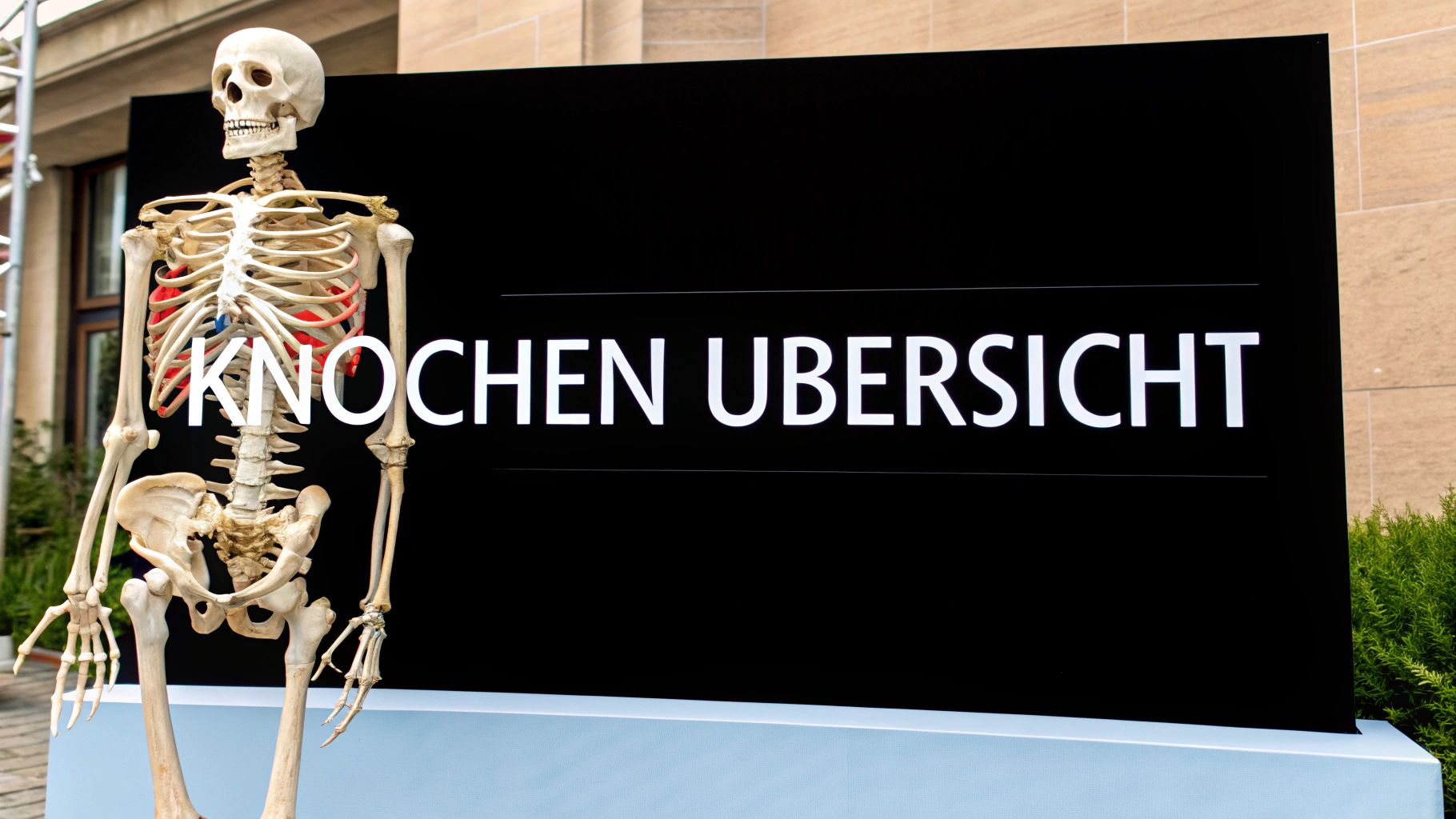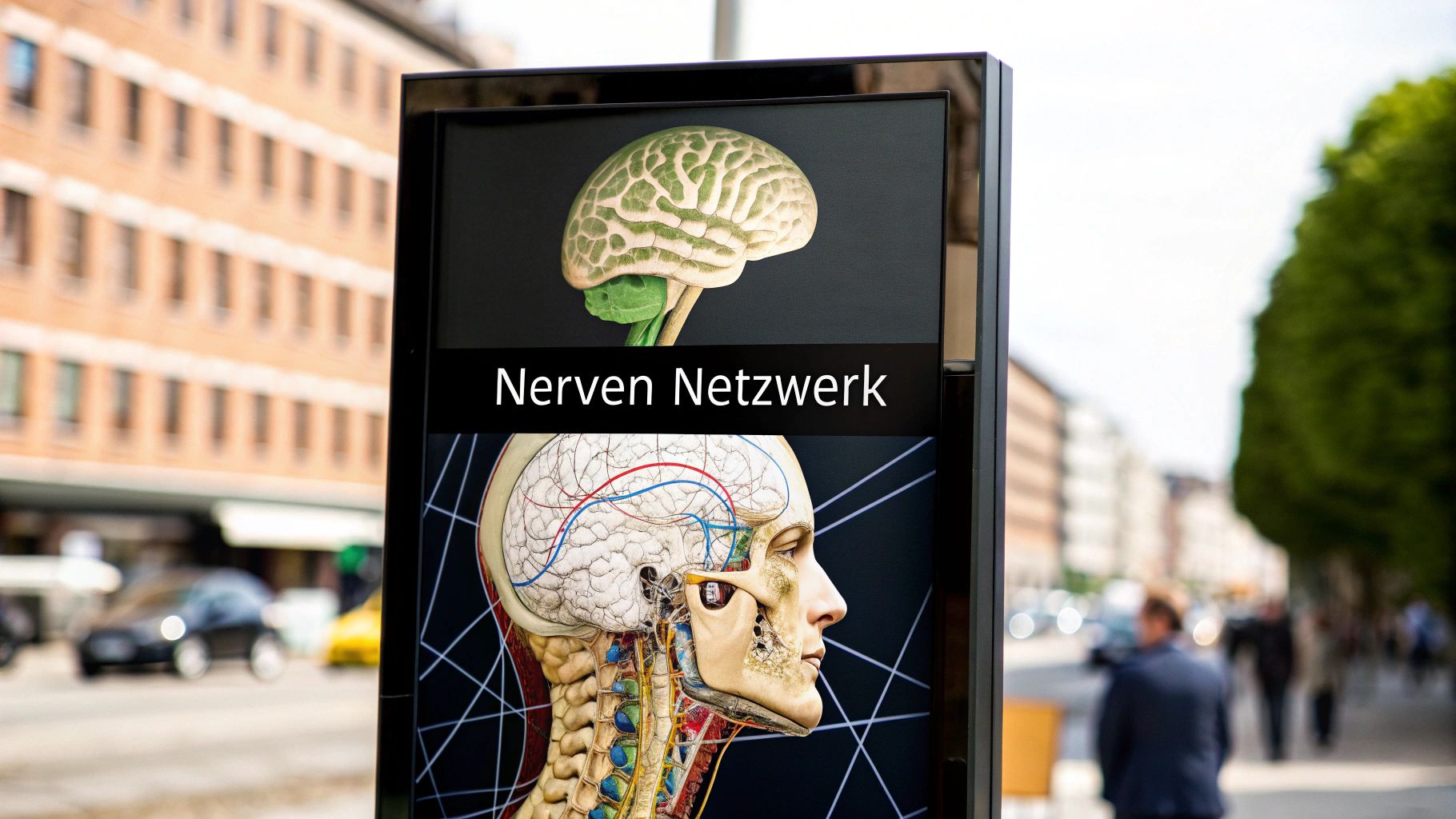Mastering the Challenge of Anatomy

From the very beginning, medical school presents aspiring physicians with a major challenge: anatomy. The sheer volume of learning material can quickly become overwhelming. But why do so many students find this area difficult, and how do successful medical professionals overcome this hurdle?
Structured Learning: The Path to Success
A common mistake when learning is the lack of structure. Anatomy is a complex and interconnected field. A systematic approach is therefore essential. Instead of memorizing individual facts, one should recognize connections and build a comprehensive knowledge network . This makes it easier to classify information and anchor it in memory. Start with the basics and work your way up to the more complex structures step by step.
Clinic and Anatomy: The Connection Makes the Difference
Another important point is the early connection of anatomical knowledge and clinical practice. Abstract information becomes more tangible and understandable when one recognizes its relevance to later medical work. Ask yourself questions: Where is this organ located? What are its functions? Which diseases can be associated with it? This approach not only promotes understanding but also increases motivation.
Learning Anatomy by the Numbers: A Look at the Statistics
Every year, numerous students in Germany begin their medical studies and have to intensively study anatomy. In the winter semester of 2023, 113,383 students were enrolled in medicine. Of these, 40,139 were men and 73,244 were women. These figures highlight the importance of the subject and the growing proportion of female students. Anatomy is and remains a fundamental element of medical training and requires comprehensive knowledge of the human body. Further information and statistics on medical studies can be found at the Federal Statistical Office.
From Challenge to Expert
Even experienced doctors and lecturers know that anatomy is a challenge. With the right approach, however, this hurdle can be overcome. Crucial are structured learning, linking theory with clinical practice, and the use of various learning resources. By combining textbooks, anatomical atlases, digital learning programs, and practical exercises, a solid anatomical foundation can be established. This forms the basis for successful studies and later medical practice. This is how the initial challenge becomes an important step on the path to becoming a medical expert.
Multisensory learning methods that truly work

Successful anatomy learning means more than just memorization. It's about anchoring knowledge sustainably in memory. The combination of different sensory channels can make a decisive contribution here.
Seeing, Hearing, Touching: Understanding Anatomy
Visual learning tools are essential in anatomical studies. Atlases, illustrations, and anatomical models help to internalize complex structures. Combining them with auditory stimuli, such as podcasts or videos, further improves information absorption.
It becomes even more effective when the sense of touch comes into play. Anatomical models or participation in dissection courses offer a haptic experience and promote spatial understanding.
Anatomy in Motion: Active Learning
Movement can support anatomy learning. By recreating movements or drawing anatomical structures, what has been learned is better retained. For example, one can trace the movement of the biceps brachii muscle on one's own body and name the involved muscles and bones.
The combination of movement and language strengthens the understanding of anatomical relationships.
Spaced Repetition: Outsmarting the Forgetting Curve
Spaced Repetition is an effective learning method. Repetitions at increasingly larger intervals significantly improve memory performance. Knowledge is anchored in long-term memory through regular repetition, effectively combating the forgetting curve. Further information on learning methods can be found here: How to master...
Structure and Function: Understanding the Connections
Learning anatomy should go beyond simply memorizing structures. It is important to understand the function of individual structures and their role in the overall system of the body. How do organs work together? What are the effects of injuries to certain structures?
This understanding is not only important for learning, but also the foundation for later clinical practice. Research on the anatomy of learning provides interesting insights here. Researchers from the Max Planck Institute for Human Development are investigating how the brain changes during learning.
Studies show that cognitive abilities can be improved through training. This knowledge helps to develop more effective learning strategies for anatomy and other complex subjects. More information on this topic can be found here . Understanding learning processes is essential for effective anatomy learning.
Memory aids that stick

Learning anatomy poses significant challenges for many students. The sheer volume of technical terms and the complexity of the structures can quickly become overwhelming. However, with the right learning methods, this hurdle can be overcome. Mnemonics are a particularly effective tool. They help to simplify complex relationships and anchor them sustainably in memory.
Why mnemonics work
Our brain stores information more easily when it is linked to emotions, images, or stories. Mnemonics utilize precisely this principle. They form a bridge between abstract anatomical knowledge and memorable images or rhymes. This makes learning not only more effective but also more enjoyable.
Learning anatomy often requires creative learning strategies. Meditricks , a team of medical students and physicians, recommends the use of mnemonics to better internalize complex anatomical names and structures. Names likeM. sternocleidomastoideus or N. obturatorius are easier to remember this way.
Different Types of Mnemonics
For learning anatomy, there are different types of mnemonics that are particularly well-suited:
-
Rhymes and sayings:An example of this is: "Remember: Aorta ascendens, up it goes, Aorta descendens, down it goes."
-
Stories and images:For example, imagine the carpal bones as small figures experiencing an adventure. Visualization helps enormously!
-
Acronyms:Form a word from the first letters of the structures you want to learn. This is especially helpful for the cranial nerves.
-
Numbers and Facts:Connect numbers with memorable stories or images. This makes it easier to remember quantitative information as well.
Below you will find a table with some examples of mnemonics that can help you learn anatomy:
Powerful mnemonics for complex anatomical structures
This collection presents proven memory aids that work reliably even during stressful exams
| Anatomical Structure | Mnemonic | Explanation |
|---|---|---|
| Ascending/Descending Aorta | "Ascending aorta, starts at the top, descending aorta, starts at the bottom. | Rhyme to distinguish the sections of the aorta |
| Carpal bones | Story with figures | Visualization of bone arrangement |
| Cranial nerves | "Uncle Otto plays the organ daily, but on Fridays Gustav tries completely silly homework." | Acronym for the order of the cranial nerves |
This table shows how diverse mnemonic devices can be and how they support learning.
Develop your own mnemonics
The most effective mnemonics are the ones you create yourself. Let your creativity run wild! The more unusual and personal your mnemonic, the better it sticks. It is important that the mnemonic makes sense to you and is easy to remember.
Organization and Application
A constantly growing collection of mnemonics requires a good organizational system. Create a list or flashcards to maintain an overview. Practice regularly with your mnemonics and apply them in different contexts to consolidate what you have learned.
Example: The Cranial Nerves
The twelve cranial nerves are a challenge for many medical students. A mnemonic makes it easier to remember the order: "Onkel Otto orgelt tagtäglich, aber freitags versucht Gustav völlig alberne Hausaufgaben." Each initial letter stands for a cranial nerve. This example illustrates how simple mnemonics can help anchor complex anatomical structures in memory.
Digital tools that support your learning process

Digitalization is also shaping the way we learn anatomy. A variety of digital tools are available. But which ones are really worthwhile? The sheer number of apps, programs, and online resources can be overwhelming. A well-founded selection of the right tools for your individual learning strategy is crucial.
Anatomy Apps: Flexible Learning Anytime
Anatomy Appsoffer a flexible way to learn anatomy anywhere, anytime. Apps like Visible Body ,Complete Anatomy and Kenhuboffer interactive 3D models, detailed illustrations, and integrated learning quizzes.
The ability to view and rotate anatomical structures from different angles promotes spatial understanding. This is a huge advantage over static images in textbooks.
Learning appsare playing an increasingly important role in medical studies. Organs 3D Anatomy provides detailed visualizations and is particularly useful for exam preparation. Paid apps like the Prometheus app offer extensive flashcards and testing options. Learn more about learning apps for medical studies. These apps enable flexible learning on the go.
Learning platforms and online resources
In addition to the apps, there are countless online platforms . These offer learning videos, interactive exercises, and additional materials that optimally supplement classic textbooks and atlases. Platforms often offer opportunities to connect with other students.
The right combination is key
Digital tools are a valuable addition to classic learning with books, atlases, and anatomical models. They offer new possibilities to deepen and consolidate learning material, but they do not completely replace these. A combination of different learning methods is crucial for learning success.
Personalized learning and progress monitoring
Many digital tools offer personalized learning plans and the option for progress monitoring . This allows you to focus on the areas where you are still having difficulties.Intelligent learning algorithms dynamically adjust the difficulty level of the exercises to your learning progress, ensuring an efficient and motivating learning experience.
To give you an overview of the different offers, you will find a comparison table here:
The Most Effective Anatomy Learning Apps Compared
Detailed analysis of the leading digital tools with a focus on practical applicability and real learning progress
| App/Tool | Main Features | Special Strengths | Price | Rating |
|---|---|---|---|---|
| Visible Body | 3D models, animations, quizzes | Detailed visualizations, wide range of functions | Varies depending on subscription | Excellent |
| Complete Anatomy | 3D models, courses, learning materials | Extensive library, interactive features | Varies depending on the subscription | Very good |
| Kenhub | Videos, Quizzes, Flashcards | Structured design, focus on clinical relevance | Varies depending on the subscription | Good |
This table should help you choose the right tool. For further helpful resources regarding medical studies, please visit our Sitemap. Read also: How to master...
Practical tips for integrating digital tools
- Integrate digital learning phases into your everyday life: Use short breaks to review with an app.
- Combine digital and analog learning methods: Link what you have learned from the app with your anatomy atlas.
- Use different devices: Learn flexibly on your computer, tablet, or smartphone.
- Exchange ideas with other students: Discuss your experiences with different learning apps.
With the right selection and application, digital tools can support your learning process and accompany you on your path to successful medical studies.
Optimally Utilizing Anatomy Atlases: More Than Just Picture Books
Anatomy atlases are indispensable in medical studies. But how do you use them effectively? They are much more than a collection of impressive images; they are tools for the active learning process.
The Right Atlas for Your Needs
Not every atlas is the same. Classics like Sobotta ,Prometheus and Thieme each have their strengths. The Sobotta is known for its detailed drawings and is excellently suited for topographic anatomy. The Prometheus impresses with its clear presentation and is ideal for a quick overview. The Thieme offers a good balance of detail and overview.
Further information on various learning resources can be found here.
Active Learning with the Atlas
Simply browsing is not enough. Active learning techniques are crucial. Mark important structures, create labels, and add notes to the atlas. Link the illustrations to clinical cases and question the function of the structures.
From Image to Understanding: Connecting Text and Image
Combine the knowledge from the atlas with your textbooks. Compare illustrations and look for connections. This way you will understand anatomical structures and their functions more comprehensively. The use of anatomy tools has changed. A 2017 survey at the University of Münster showed that two-thirds of students were unfamiliar with resources like IMAIOS and Amboss , while three-quarters were familiar with Visible Body, Thieme eRef and the Sobotta Atlas. This shows the varying familiarity with learning resources. More information can be found here .
Exam preparation with the atlas
During exam periods, the atlas is a valuable reference work. Through markings and notes, you can find information quickly. Practice navigating the atlas to save time during the exam.
Create personalized learning materials
Create your own learning materials with your atlas. Copy illustrations, label them, and create flashcards. This way you can prepare the learning material individually.
Tips for marking and annotating
- Use different colors for different structures.
- Create a legend for your markings.
- Write short, concise notes.
- Supplement the atlas with sketches and diagrams.
This is how your anatomy atlas becomes an important tool for effective learning and application of anatomical knowledge.
From dry knowledge to clinical brilliance
The crucial difference between average and outstanding medical professionals lies in the practical application of anatomical knowledge. How does the seemingly abstract knowledge from the dissection room transform into life-saving competence?
Topographical thinking: The key to diagnosis
The clinical anatomy builds upon the foundations acquired in the dissection room and expands them with the ability to spatially assign symptoms and findings. This topographical thinking is essential for diagnosis and therapy. Where exactly is the affected organ or tissue located? Which adjacent structures could be involved?
An example: Pain in the lower right abdomen. The physician must differentiate the possible causes based on the location of the pain and other symptoms. Knowledge of the location of the appendix, cecum, and surrounding organs is crucial here.
Anatomy in Action: Case Studies from Practice
Case studies illustrate the relevance of clinical anatomy. Back pain can be diagnosed more precisely with accurate knowledge of spinal anatomy . Is the cause in the muscles, the intervertebral discs, or the nerve roots?
Also, neuroanatomy plays an important role. Neurological deficits can be better classified and treated through understanding the course of the nerves in the brain and spinal cord.
Clinical Correlations: Motivation and Deeper Understanding
Students should establish clinical correlations early in their studies. This not only promotes motivation , but also leads to adeeper understanding of the subject matter. Why is the course of the femoral artery important? Because it can be vital in leg injuries.
Linking anatomy and clinical practice makes abstract structures tangible. The human body is understood as a complex system in which every organ, every muscle and every nerve fulfills its function.
The mental atlas: Your constant companion
The goal of anatomy learning is to build a mental atlas . This atlas contains the most important anatomical structures and their spatial relationships. It serves as a basis for topographical thinking and supports clinical decision-making.
Exercises linking symptoms and anatomy help in building this mental atlas. Shortness of breath – which structures could be affected? Lungs, bronchi, diaphragm and the involved nerves and muscles.
From Student to Clinician
The clinical application of anatomical knowledge is a continuous process. It begins during studies and continues in everyday clinical practice. Through constant engagement with anatomical structures and clinical cases, topographical thinking is refined and the mental atlas gains in detail.
Discover the fascinating world of anatomy with Animus Medicus . Find high-quality vintage-style anatomy images and accessories that stylishly present medical knowledge. Visit us atanimus-medicus.de and be inspired!
Article created usingOutrank